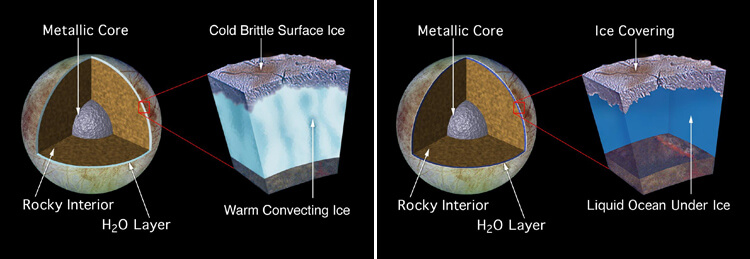
2029-2034
Jupiter Icy Moons Explorer (JUICE) explores the Jovian system
Jupiter Icy Moons Explorer (JUICE) is a mission by the European Space Agency (ESA) to explore the Jovian system, focussing on the moons Ganymede, Callisto and Europa. Launched in 2022, the craft goes through five gravity assists (Earth, Venus, Earth, Mars, Earth), before reaching Jupiter in late 2029.*
For its primary objective, the probe performs a series of flybys around some of the largest Galilean moons – Ganymede, Callisto and Europa, all of which are believed to hold subsurface liquid water oceans. As a secondary objective, it also studies Jupiter’s atmosphere and magnetosphere, gaining valuable insight into how the gas giant might have originally formed.
The main science goals for Ganymede, and to a lesser extent for Callisto, are:
- Characterisation of the ocean layers and detection of putative subsurface water reservoirs
- Topographical, geological and compositional mapping of the surface
- Study of the physical properties of the icy crusts
- Characterisation of the internal mass distribution, dynamics and evolution of the interiors
- Investigation of Ganymede’s tenuous atmosphere
- Study of Ganymede’s intrinsic magnetic field and its interactions with the Jovian magnetosphere
For Europa, the focus is on the chemistry essential to life, including organic molecules, and on understanding the formation of surface features and the composition of non-water-ice material. Furthermore, JUICE provides the first subsurface sounding of the moon, including the first determination of the minimal thickness of the icy crust over the most recently active regions.

Two possible models of Europa. Credit: NASA
JUICE begins at Ganymede, the largest moon in the Solar System, which it swings past at close range in October 2029. Several hours after this manoeuvre it prepares for orbital insertion at Jupiter itself. This highly elongated first orbit leads to JUICE’s closest approach to Jupiter in May 2030. The following month it performs another Ganymede flyby and then further studies of Jupiter, with orbits around the planet becoming less elongated and more circular.
JUICE then flies past Europa in October 2030, before returning to orbits around Jupiter, which are highly inclined to allow observation of the polar regions and a detailed study of the magnetosphere. Callisto is the next target for study and this moon (the most heavily cratered in the Solar System) is reached in April 2031.
JUICE then returns to high inclination orbits round Jupiter. In 2032, it observes moon transits, i.e. moons and their shadows as they pass in front of Jupiter. Transits of both Europa and Io occur on 27th January 2032.
In September 2032, the spacecraft returns to Ganymede and enters into orbit (as opposed to a flyby), becoming the first spacecraft to orbit a moon other than Earth’s moon. This complicated manoeuvre allows it to come within 500 kilometres (310 mi), returning very close-range images of the surface. It also features a laser altimeter with 20 metre (66 ft) spot size and 10 centimetre (3.9 in) vertical resolution, revealing tidal deformations of Ganymede. With its fuel running out, JUICE is deorbited and impacts the surface of Ganymede in February 2034.
This mission, among ESA’s most significant of recent years, provides a wealth of empirical data and new insights into the Jovian system. As well as improving the general scientific understanding of the Galilean moons, JUICE also enables mission planners to determine potential landing sites for surface probes in the future. Indeed, preparations are now getting underway to further explore Europa in the 2035-2050 timeframe.
2029-2032
DAVINCI+ mission to Venus
Deep Atmosphere Venus Investigation of Noble gases, Chemistry, and Imaging, Plus (DAVINCI+) is one of two missions selected by NASA in June 2021 for its Discovery Program. The other spacecraft, VERITAS, is launched in 2028. DAVINCI+ follows a year later in 2029.*
Both missions complement each other and greatly improve the scientific knowledge of Venus. While VERITAS is focused on mapping and surface features, DAVINCI+ has the primary objective of studying the atmosphere. In addition to the main spacecraft, it also includes a descent sphere.
The orbital component of the DAVINCI+ mission performs multiple flybys of the planet, utilising a multi-band imaging system that includes near-infrared (NIR), ultraviolet (UV) and an engineering wide-field mode. This reveals previously unseen features of the planet and includes opportunities for nightside NIR imaging of Ishtar Terra – an Australia-sized region containing the four main mountain ranges of Venus – as well as the probe landing site in Alpha Regio consisting of heavily deformed terrain. During this time, it also maps the clouds of Venus and conclusively determines the presence of phosphine, which had previously been suggested as a life signature.* As well as gathering data and imagery from orbit, the spacecraft acts as a relay for the descent probe, deployed in 2031.
The combination of both DAVINCI+ and its sister mission, VERITAS, sets the stage for a new and enduring period of Venus exploration by NASA that extends into the 2040s.* Other national space agencies are probing the planet around this time, including ESA, ISRO and Roscosmos.
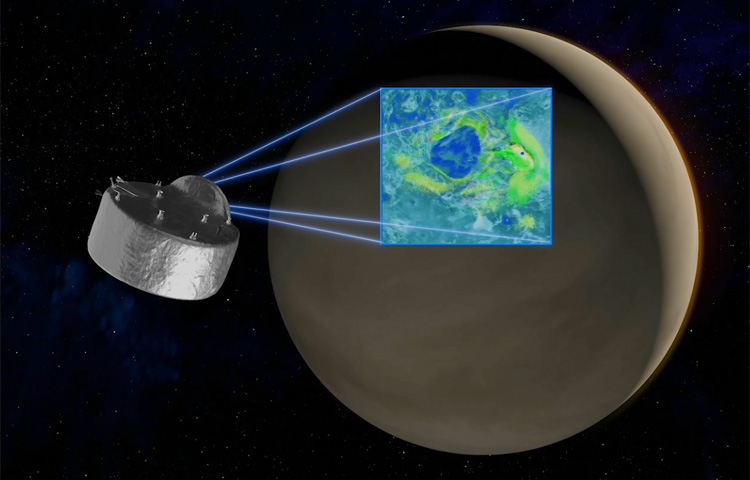
2029
Human-like AI is becoming a reality
By the end of this decade, a milestone is reached in artificial intelligence, with computers now routinely passing the Turing Test. This two-hour experiment is conducted by a human judge who is made to engage in a natural language conversation with one human and one machine, each of which tries to appear human. Participants are placed in isolated locations.
For several decades, information technology had seen exponential growth – leading to vast improvements in computer processing power, memory, bandwidth, voice recognition, image recognition, deep learning and other software algorithms. By the end of the 2020s, it has reached the stage where an independent judge is never able to tell which is the real human and which is not.*

© Rolffimages | Dreamstime.com
Romania adopts the euro
In 2029, Romania adopts the euro as its official currency, becoming the 22nd member state of the European Union (EU) to do so. This follows Bulgaria (2024) and Croatia (2023).
Like those previous countries, Romania had to meet several criteria before its transition would be possible. After joining the EU in 2007, it worked towards the financial strength, stability, and flexibility required, achieving four of the seven criteria by 2014.
In subsequent years, however, Romania encountered a number of setbacks. The European Commission’s (EC’s) Convergence Report of 2020 concluded that it did not fulfil the price stability, public finances, exchange rate, and long-term interest rate criteria.
Prime Minister Florin Cîțu stated that Romania could join the eurozone in 2027 or 2028. As a precursor to full adoption of the euro, Romania joined the EU’s exchange rate mechanism (ERM II), after working to address concerns around its budget deficit to GDP ratio, inflation rate, long-term interest rate, and compatibility of legislation.
Having met all the criteria and with two years of stability, Romania is accepted into the eurozone. The leu, its national currency since 1867, is finally replaced by the euro in 2029.*
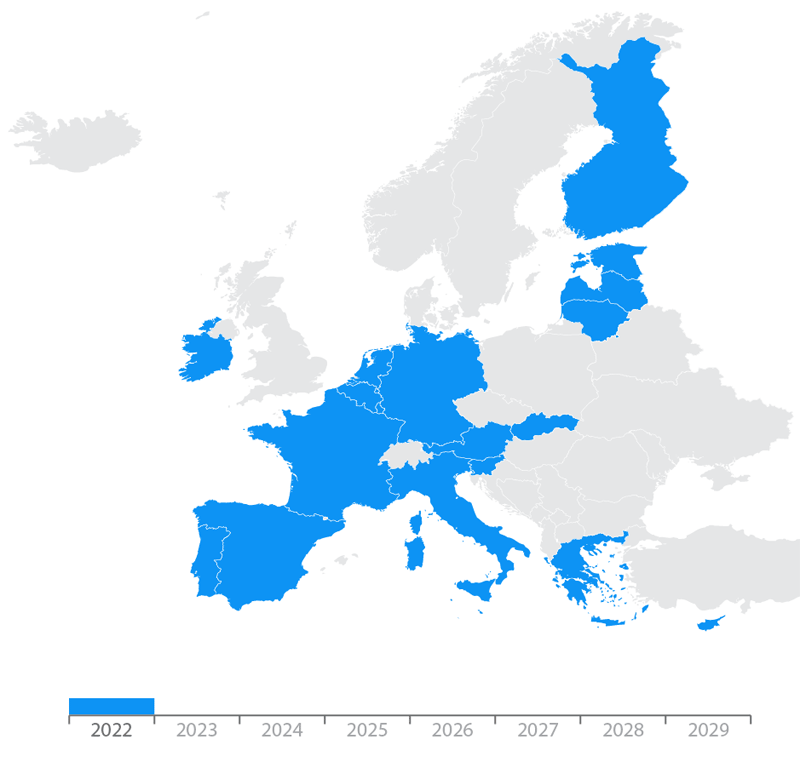
Increased automation of banking
During the early 21st century, a wave of new technology swept the banking sector, as companies worked to improve costs and efficiencies. Online services, combined with mobile apps, automated chatbots, virtual telephone assistants, increasingly sophisticated ATMs, and other features all made it quicker and easier than ever to manage one’s personal finances. On the business and corporate side, the rise of cloud computing, big data and intelligent algorithms yielded significant time and cost savings in research, marketing, processing and other areas, while giving more power and insight to decision makers.
By 2020, U.S. banks alone were investing more than $150 billion in new technology annually, spending more than any other industry.* While customers and clients benefited greatly from these improvements, automation reduced the need for human staff. By 2029, more than 10% of banking jobs have been eliminated compared to a decade earlier, adding up to some 200,000 roles in the U.S.* Retail branches and call centres are the hardest hit, where over a quarter of staff are no longer needed. Commercial and investment bank employees are less vulnerable for now, but even these jobs become threatened in subsequent decades as decision making is delegated to ever more powerful hardware and algorithms.

Close approach of the near-Earth asteroid Apophis
99942 Apophis is an asteroid with a diameter of 370m (1,214 ft) and an exceptionally close orbit to Earth. It caused a sensation in 2004 when initial observations indicated a 2.7% chance that it would hit Earth in 2029. This gave it the highest rating ever recorded on the Torino impact hazard scale, reaching level 4.*
Depending on its composition, location and angle of entry, the asteroid would make atmospheric entry with up to 1,200 megatons of kinetic energy – approximately 21 times more than the Tsar Bomba, the largest nuclear weapon ever tested – and six times more than the 1883 eruption of Krakatoa.
However, the orbital characteristics of Apophis were later refined, eliminating any chance of an impact. Nevertheless, the object remains on an alarmingly close path that skims within 31,000 km of Earth, which is 10 times closer than the Moon, and even closer than some man-made satellites.
Apophis is triple the size of 2019 OK, another large object that passed by in July 2019 and comes even closer than that earlier asteroid. Its close passing sparks further debate about the need to defend Earth from potential impacts.
Mass application of gene drives on mosquitoes
During the 2010s, it was estimated that nearly 700 million people were catching mosquito-borne illnesses, resulting in over a million deaths worldwide each year. In spite of the insects’ tiny size, they were the deadliest creatures in the world, killing more humans than any other animal. Among the diseases being transmitted were malaria, dengue fever, West Nile virus, yellow fever, chikungunya, filariasis, the Zika virus and many others.
Affecting mostly tropical and sub-tropical regions, the majority of deaths were of young children in sub-Saharan Africa. However, in 2015 it was reported that – due to warming temperatures from climate change – mosquitoes had begun spreading historically rare diseases into Europe: malaria to Greece, the West Nile virus to parts of Eastern Europe and chikungunya to Italy and France. Malaria and West Nile virus were becoming more common in North America too.
The economic and social costs of mosquito-borne infections were often considerable. An individual could be forced to miss time at work or their place of education, pay for doctors’ visits and related travel, obtain funds to cover prescription or over-the-counter medicines, pay for hospital bills or medical treatment, and buy insect sprays or repellents to prevent further bites. There were also funeral expenses in the case of deaths. At a national level, the costs to governments included the maintenance and staffing of health facilities, the purchase of drugs and vaccines, public education programs to warn about epidemics, research to prevent further outbreaks and to improve treatments, lost productivity and overall damage to businesses, negative effects on tourism and sports events, as well as compensation for affected communities.
Of the many and various mosquito-borne illnesses, malaria presented the greatest threat, with 3.2 billion people (106 countries and territories) located in areas at risk of transmission. It was a particularly acute problem in Africa, where an estimated 91% of malaria deaths occurred. This disease alone was causing $12 billion in economic damage to the continent each year, reducing the annual Gross Domestic Product (GDP) of some countries by as much as 1.3%. In those nations where the disease was most common, it represented up to 40% of public health spending and could account for 60% of visits to health clinics, along with 50% of hospital admissions.
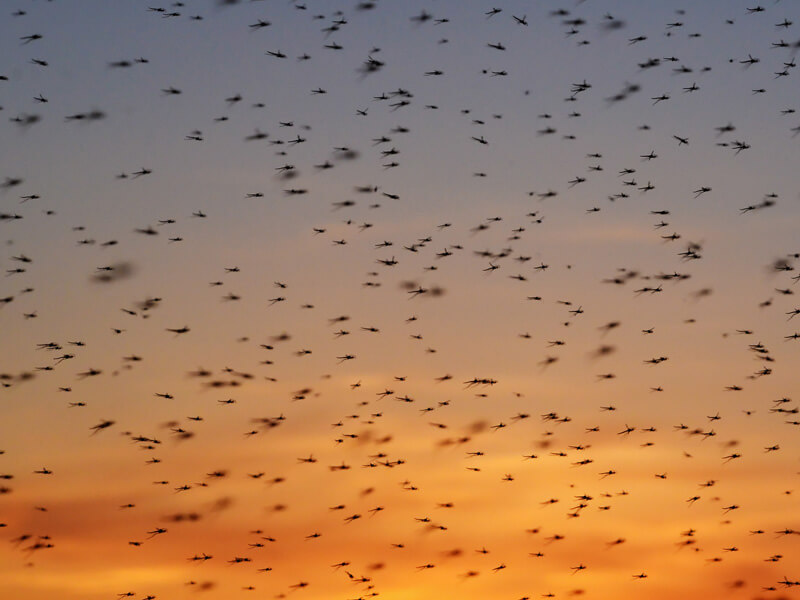
A variety of methods were in use to control mosquitoes – including the elimination of breeding places (such as pools, ditches, old tires, buckets and other containers of stagnant water); physical barriers like window screens and nets; sprays and repellents; attractant-laced traps; and biological control via fungi and nematodes or predators such as fish. Another strategy was the use of pesticides, but these were gradually becoming less effective as the insects developed resistance, plus the chemicals were damaging to the environment.
While research into vaccines and new medications was now showing promise, a more comprehensive and long-term proposal was to eradicate mosquitoes – or at least drastically reduce their ability to spread infections. Known as a “gene drive”, it was hoped that such an initiative would either A) cause the extinction of several of the major vectors of malaria (and some other diseases like dengue and Zika) including Aedes albopictus and Anopheles, or B) induce a massive genetic change throughout the mosquito population, making them unable to transmit vectors.
The ability to modify animal and plant DNA had been around for decades already. The first genetically modified animal was a mouse created in 1973. The first genetically modified crop, an antibiotic-resistant tobacco plant, was produced in 1982. These organisms were still subject to the laws of genetic inheritance, however, as first described by Gregor Mendel in 1865. In other words, if a mosquito carrying altered DNA were to mate with another mosquito, there would only be a 50-50 chance of the offspring inheriting the modified gene. The probability would be even lower that a subsequent generation would pass on the modified gene, and so on.
Gene drives, by contrast, were designed to change the fundamental laws of inheritance. A powerful new editing technique known as CRISPR/Cas9 was demonstrated on fruit flies in the 2010s, showing that it was possible to engineer organisms in which every generation received a modified gene – and an entire population would get it within a few generations. With potential for large-scale transformation of species, attention turned to the problem of mosquitoes in Africa.
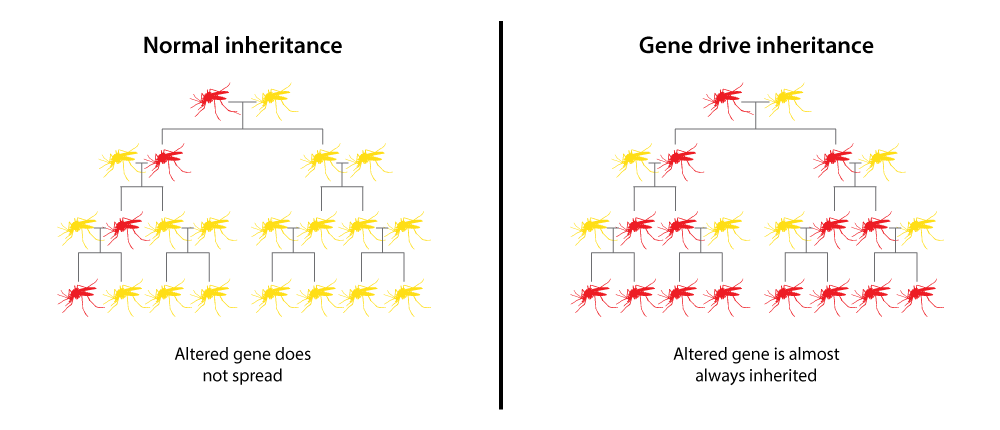
This process of artificially biasing inheritance of desired genes was described as a “mutagenic chain reaction” by researchers. While holding great promise, there were also a number of risks and ethical issues. By altering mosquitoes’ DNA to ensure their offspring would always be male, for example, and releasing them into the wild to mate with natural mosquitoes, malaria and other diseases could be wiped out. However, there could also be side effects. Causing the insects’ populations to crash might disrupt food chains or have other unforeseen consequences.*
Government reports highlighted these and other areas of concern, delaying the mass introduction of gene drives,* but this was only a temporary setback as major investment was going into research and development of the process. Among the biggest supporters in the fight against malaria was Bill Gates whose foundation had committed almost $2 billion in grants between 2000 and 2015 to combat the disease.
To safeguard against the dangers, a “reversal drive” was developed alongside the gene drive that could, if necessary, undo the process and spread the original genes back into the population. In addition, other alternatives to creating all-male offspring were considered – such as introducing genes to make the insects target animals rather than humans, or genes that stopped the parasite itself from multiplying inside the insect.
Laboratory tests were conducted before the introduction of these GM mosquitoes into the wild. Detailed studies then followed to determine the optimal numbers and best locations to release the insects, as well as the various cause-and-effect pathways in the environment. Following small-scale experiments in the early 2020s, the mass introduction of gene drives is becoming a reality towards the end of the decade. After years of mutagenic chain reactions, follow-up assessments and computer models, researchers have pieced together a trove of evidence and data, refining the process to be safe and with acceptable impacts on the environment. These and other issues have now been largely resolved, with most nations in Africa and elsewhere having approved the use of gene drives. A sharp drop in malaria is being witnessed by 2029.*
Other pests and invasive species are being targeted using this method – cane toads in Australia, for example; locusts that swarm and destroy crops; rodents that carry diseases. Unfortunately, given their enormous power and potential, gene drives are also now coming under intense scrutiny for an altogether different and more sinister reason: their ability to be used as bioweapons on human populations. This is leading to increased transparency, openness and cooperation between governments around the world to ensure better monitoring of scientific research activities and to make safeguards and countermeasures built into gene drives.*
Finland bans coal for energy use
In 2029, Finland implements a nationwide ban on coal use. The country’s greenhouse gas emissions had already peaked in the early 2000s, but it was still reliant on coal for its energy, with 11 million tons burned each year. Lacking any domestic production of its own, this was imported from other nations – primarily Russia (72%), the USA (7%), Canada (6%), Australia (6%) and Poland (3%). The percentage of coal as an energy source in Finland declined from 18.6% in 1980 to 14.7% in 1990 and 11% in 2000, rising again slightly before entering a permanent decline from 2003 onwards and reaching 8% by 2018. The ban was announced in February 2019 and comes into effect from 1st May 2029.*
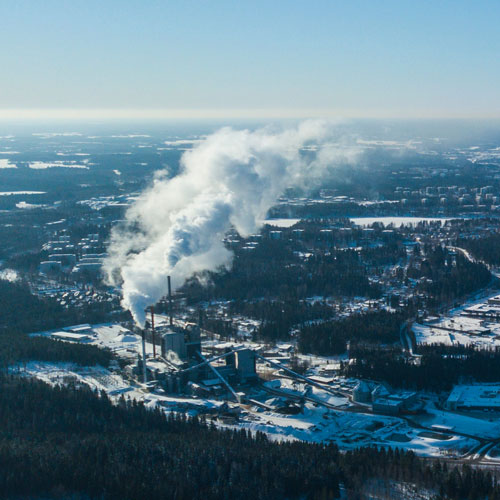
Madagascar’s radiated tortoise is extinct in the wild
Years of unmitigated hunting and loss of habitat, as well as capture for the illegal exotic pet trade, have caused the wild population of the radiated tortoise to dwindle to almost nothing.* Like over 80% of the island’s flora and fauna, the radiated tortoise can be found nowhere else on Earth naturally.
The government of Madagascar attempted to halt the decline by introducing a series of protection laws. Unfortunately, the size of the island’s wildlife areas and poor economic conditions meant these restrictions were all but ignored. Even protected areas were invaded by poachers. Surveys in the 2010s revealed a shocking decline in the number of tortoises. The breeding population quickly shrunk throughout the 2020s.
Though there is hope of future repopulation using those bred in captivity, the shrinking habitats they once occupied make this prospect unlikely. In another 15 years or so, almost all of Madagascar’s forests will be gone.*
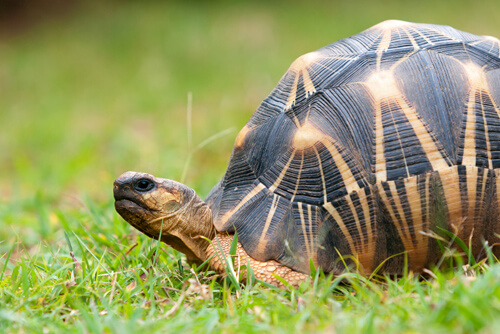
Phase 1 of the California High-Speed Rail line is complete
The California High-Speed Rail line is a major transportation project to modernise the rail routes on the west coast of the United States, making them fit for the 21st century. It connects Los Angeles to San Francisco, with trains running at speeds of up to 200 miles per hour (320 km/h), enabling journeys between the two cities in under three hours. Plans for a high-speed rail system linking Northern and Southern California were proposed by Governor Jerry Brown in the 1980s, but it took until 2008 for funding to be approved by voters. Even then, criticism remained over the budget, feasibility, legal, environmental and other issues. Covering 800 miles and 24 stations, the total cost would amount to over $68 billion.
A ground-breaking ceremony for the project was held in January 2015.* Construction would proceed in various segments. The initial 130-mile (209 km) stretch from Fresno to Bakersfield in the Central Valley would open in 2022, followed by several other sections, leading to Phase 1 completion in 2029.* This would be followed by Phase 2, consisting of two extensions: a 110 mile (177 km) route from Sacramento to Merced and a 167 mile (269 km) route from Los Angeles to San Diego. Over a 58 year period (from the start of operations in 2022 through 2080), the system reduces auto travel on the state’s highways and roads by over 400 billion miles; a significant reduction in air pollution and carbon emissions for the region. Other benefits include the creation of 450,000 permanent jobs through the new commuters using the system.
Alongside the California High-Speed rail line is a private venture known as XpressWest (formerly DesertXpress) that aims to build a high-speed route from Victorville to Las Vegas. Other rail projects are now taking shape across the USA. On the other side of the country, the Washington to Newark section of the Northeast Corridor route is nearing completion.*
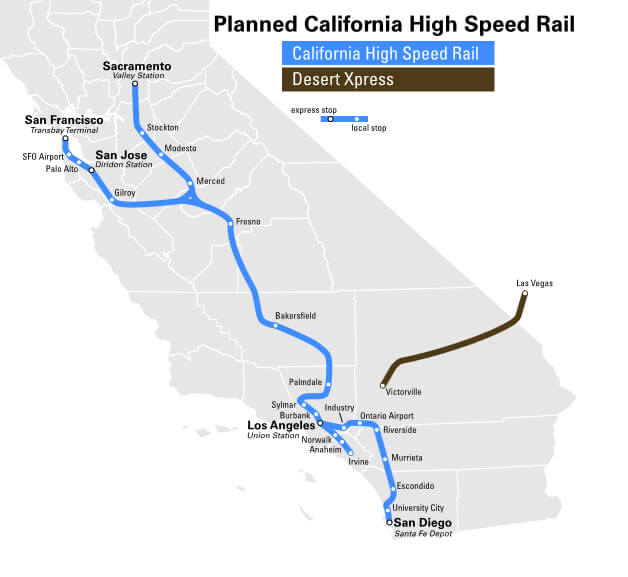
Credit: Thadius856 derivative work: CountZ [CC BY-SA 3.0], via Wikimedia Commons
Expansion of London’s Heathrow Airport
For many years, Heathrow Airport in London held the title of world’s busiest airport when measured by international passenger traffic, as well as the busiest in Europe by overall passenger traffic. By the early 2010s, it was handling 70 million passenger journeys per year (though Dubai International would eventually overtake it) and forecast to reach 85 million by 2030. As the airport began to reach 100% capacity at peak times, concerns were raised about overcrowding and the need for expansion. Globally, air traffic in general was growing rapidly – due in large part to booming demand from the emerging markets of the Asia Pacific and Middle East regions – and the number of planes in service was projected to double between 2015 and 2035.
In 2009, the UK’s Labour government announced that it would support the expansion of Heathrow and encouraged the airport operator (BAA) to apply for planning permission. However, these plans were cancelled the following year by the new coalition government of the Conservatives and Liberal Democrats. Following several more years of planning and reviews, the Airport Commission recommended a third runway and sixth terminal. A full report was finally published in 2015 that confirmed a new expansion to the northwest as the chosen proposal. After further revisions, and with estimated costs of £14.3bn (funded privately), this northwest runway and terminal plan was approved by the government in 2018.
The new infrastructure would increase Heathrow’s capacity from 85 million to 130 million passengers annually. It was predicted to create 180,000 new jobs and generate £200bn in total economic benefits by 2050. Up to 40 new long-haul routes would become available. In addition to the airport itself, a number of access improvements were planned – such as the 118 km (73 mile) Crossrail line running all the way from east to west London, along with a refurbished Piccadilly line providing more spacious, air-cooled trains at higher frequencies than before.
Click to enlarge
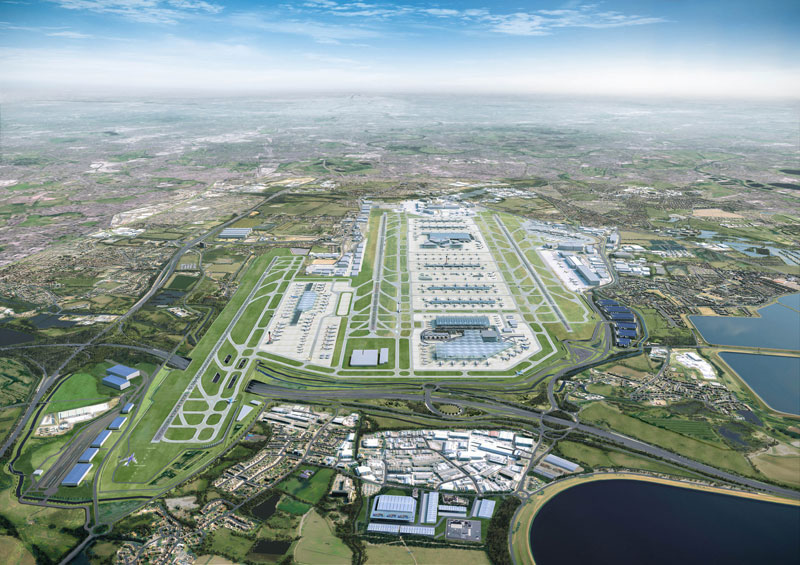
Credit: Heathrow Airports Limited
The pro-expansion stance of both Labour and the Conservatives was supported by many groups and prominent individuals, including the aviation sector, Confederation of British Industry (CBI), British Chambers of Commerce (BCC) and 32 local chambers of commerce, local authorities, the manufacturing and freight sector and trade unions.
However, there was considerable opposition too. Political opponents included the Liberal Democrats, Green Party and UKIP. Sadiq Khan, Mayor of London, and his two predecessors, Boris Johnson and Ken Livingstone, were also against it. Various campaign groups voiced concerns, including Greenpeace, Friends of the Earth, the RSPB and WWF, as well as conservation organisation The National Trust, and developmental charities Oxfam and Christian Aid, alongside Hillingdon Council – a local government in West London.
Among the biggest concerns were the impacts on local communities. Some 700 homes, a church and eight Grade II-listed buildings would have to be demolished or abandoned (Grade II being a designation given to “buildings [that] are nationally important and of special interest”, warranting every effort to preserve them). The main high street in the village of Harmondsworth would need splitting and a graveyard would have to be “bulldozed”. The entire village of Sipson was in danger of being wiped from the map.
The other major concerns were air and noise pollution, along with greenhouse gas emissions. Environmental campaigners warned that the increased CO2 caused by the additional flights would make it harder for the UK to meet its commitments to the Paris climate agreement. They also pointed to studies showing that the claimed economic benefits would be negated by the long-term costs of carbon. Building a third runway would also raise the general level of air pollution, at a time when 40,000 people were dying each year from dirty air across the country. The UK was already in breach of legal limits and the government had lost multiple court cases on the issue.
Furthermore, expanding Heathrow and its flight paths would expose hundreds of thousands of additional residents in London – as well as the neighbouring county of Berkshire – to sustained high levels of aircraft noise for the first time.
Many people also resented London gaining yet another major project, drawing money away from the rest of the UK. Other regions were falling behind and there were opportunities for investment in Birmingham and Manchester, for example. The widening gap between London and everywhere else had already created a worrying socio-economic divide. This ever-growing sense of inequality may have been a contributory factor in the Brexit referendum result.
The arguments from the opposition side were strong, but those in support were stronger. The importance of Heathrow as an international transport hub and a catalyst for wealth generation in London and the South East was deemed too great, with approval granted by the government in June 2018.*
As with many large projects of this type, however, financial issues and construction delays pushed back the original timetable. Completion of a third runway had been scheduled for 2026, but was subsequently revised to 2029.*
Launch of the ARIEL spacecraft
The Atmospheric Remote-sensing Infrared Exoplanet Large-survey (ARIEL), is a space observatory launched in 2029 as the fourth medium-class mission of the European Space Agency’s Cosmic Vision programme. It aims to observe 1,000+ known exoplanets using the transit method, studying and characterising the planets’ chemical compositions and thermal structures, simultaneously in both visible and infrared wavelengths.
ARIEL is launched to the L2 Lagrangian point (pictured below), about 1,500,000 km (930,000 mi) from Earth, where it benefits from the blockage of sunlight to maximise the potential for detecting targets. It provides a wealth of scientific data on a diverse range of exoplanets: from extremely hot, to temperate; and from gaseous to rocky. Its photometer, spectrometer, and guidance system are sensitive enough to determine the presence of clouds in atmospheres, as well as some exotic molecules that may have been missed by earlier telescopes.
In addition to revealing new insights into many previously studied worlds, the mission addresses fundamental questions about what exoplanets are made of and how planetary systems form and evolve. The European Space Agency formally approved the mission in November 2020, with a scheduled launch date of 2029.* The mission duration is four years.
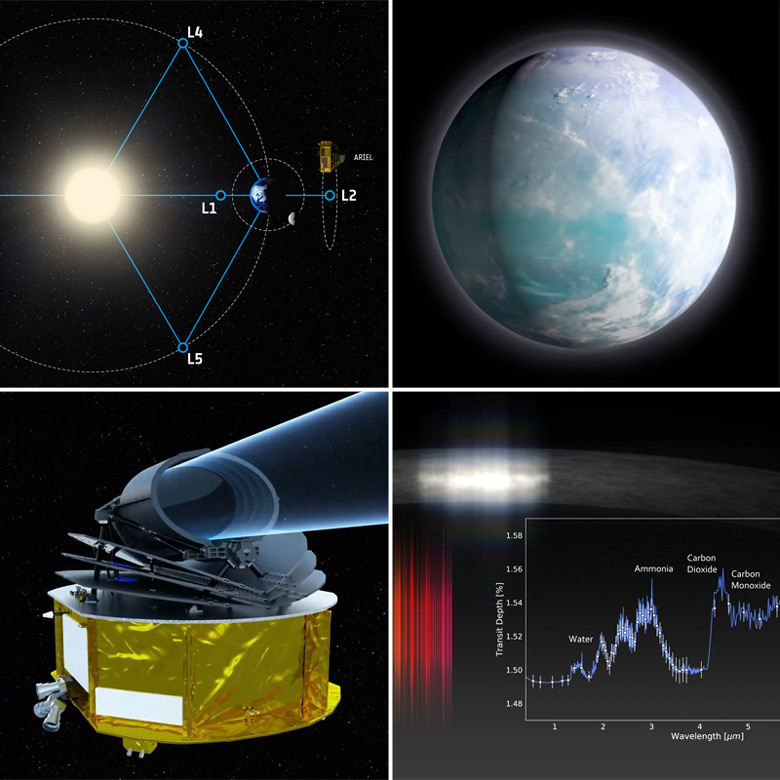
Credit: ESA
Jupiter’s Great Red Spot is disappearing
The first sightings of a Great Red Spot on Jupiter were made in the 1660s by Robert Hooke and Giovanni Cassini. This feature – a monstrous, anticyclonic storm – was not studied in detail until the late 19th century. At that time, its diameter was found to be around 25,500 miles (41,000 km), large enough to swallow three entire planet Earths.
On 25th February 1979, NASA’s Voyager 1 spacecraft returned close-range photos of the planet. These revealed that its Great Red Spot had shrunk to 14,500 miles (23,335 km). Later studies by the Hubble Space Telescope, from the 1990s onwards, revealed it continuing to get smaller in size. By 2012, the rate of shrinkage was nearly 1,000 km per year and increasing. It was theorised that small eddies, observed feeding into the storm, were accelerating this change by altering the internal dynamics. The raging winds in this turbulent region were measured to be 384 mph (618 km/h), greatly surpassing even the strongest hurricanes on Earth.
Another space probe – Juno – orbited the gas giant in 2016. This provided a greater understanding of the atmospheric composition, cloud motions, temperature, magnetosphere, gravity and other properties affecting the overall dynamics of Jupiter. Once again, the Great Red Spot was seen shrinking and losing momentum. This process would continue into the following decade. By the end of the 2020s, it has vanished entirely.** Yet another probe, Jupiter Icy Moon Explorer (JUICE), arrives this year, just as its disappearance is being confirmed.
The
wreck of the Titanic has decomposed
By the
late 2020s, the famous wreck of the Titanic has been reduced to a mere
rust patch. Metal-eating bacteria have dissolved what remains of the
once mighty structure. Though some artifacts were salvageable, any hope
*
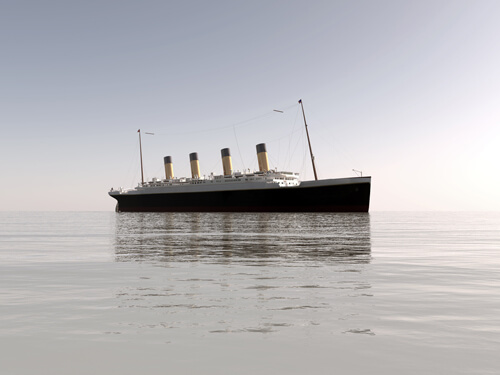
The number of satellites in Earth orbit has grown exponentially
By the
end of this decade, the number of active satellites in orbit around Earth has reached nearly 60,000 – a 20-fold increase compared to a decade earlier and a 75-fold increase since the start of the century.
Russia (then known as the Soviet Union) launched the first artificial satellite, Sputnik 1, in October 1957. Just three-and-a-half years later, more than 100 others had been placed in orbit as the Space Race got underway between the Soviets and the USA. The numbers continued to increase over the decades with more and more countries able to conduct launches for purposes such as weather monitoring, telecommunications, surveillance, and GPS.
During the early 21st century, smaller and lighter satellites with more compact and miniaturised components became increasingly popular. These provided the advantage of cheaper launch costs and a more flexible range of uses. This segment of the market became divided into various classes depending on the weight of the spacecraft – from “mini” satellites (between 500–100 kg), descending through micro, nano, pico and femto satellites, the smallest being less than 0.1 kg.
Concerns mounted over the accumulation of space debris from old satellites and other defunct or abandoned objects. In a worst-case scenario, this might trigger a catastrophic chain reaction of collisions – known as the Kessler syndrome* – with potential to block safe access to space for generations.
Despite the growing risk, satellite numbers began to explode from the late 2010s onwards. SpaceX announced plans for Starlink, a huge constellation to expand global Internet coverage, as well as satellites for military, scientific and other purposes. Many rival companies emerged with similar projects that collectively appeared set to transform the already crowded space above Earth, creating a kind of “satellite singularity”.
The 2,600 active satellites in 2020 would be joined by a further 57,000 over the next 10 years,* bringing the total to almost 60,000. Astronomers had earlier reported interference with ground-based observations and the spoiling of the night sky, a problem now made even worse. Satellite developers responded with new measures to reduce reflected sunlight through spacecraft orientation, sun shielding, and surface darkening.
The end of this decade is marked by the emergence of a quantum Internet, providing absolutely secure encryption.* This orbiting network, still at an early stage of deployment in 2029, is massively expanded during the 2030s.